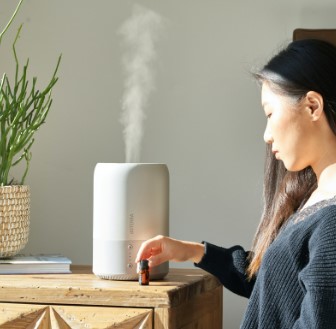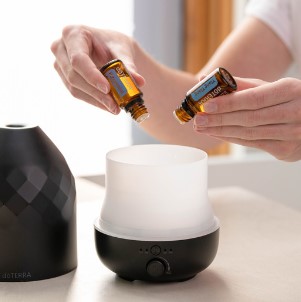If you’re a plant enthusiast, you definitely know how important it is to provide your plants with the right conditions for them to thrive.
One of the most critical factors for the growth of plants is the amount of moisture in the air or rather the amount of moisture you provide your plants with if you are keeping them in an enclosed space.
While there are various ways to humidify your plants’ environment, you might be wondering if you can use a diffuser as a humidifier for your plants, especially if you have one lying around in your home or you are not interested in investing in a humidifier.
So, Can you use a diffuser as a humidifier for plants? The simple answer is yes. You can use your diffuser as a humidifier as long as you ensure that any essential oil that you use in the diffuser is natural and free from toxins that can harm your plants.
In this post, we’ll explore the differences between a diffuser and a humidifier, and address whether a diffuser can effectively humidify the air for your plants, among other concerns that you might have.
So, if you’re curious about this plant care hack, here is a summary of what we will cover:
- Can I use a diffuser as a humidifier for plants?
- What to do if you don’t have a humidifier for plants?
- Do plants like oil diffusers?
- Can you put just water in a diffuser?
- Does a bowl of water increase humidity for plants?
Can I Use a Diffuser as a Humidifier for Plants?

Using a diffuser as a humidifier for plants can be a convenient and cost-effective option for increasing the humidity around your plants, especially if you have a medium-sized or large diffuser that will provide your plants with the humidity they need.
A diffuser is commonly used to disperse essential oils into the air through the use of ultrasonic vibrations. When you turn on your diffuser, these vibrations create a fine mist that can help to increase the overall humidity in the air around your plants.
If you have added essential oil to the diffuser, the scent around your home will change depending on the essential oil you have used. It is also important to note that, essential oils can contain a wide range of additives that might or might not be safe for you and your plants.
There are several advantages to using a diffuser as a humidifier for your plants. For instance, diffusers are generally easy to use and maintain and their working mechanism is similar to that of a humidifier.
As such, if you fill your diffuser with water and place it close to your plants, it will function like a humidifier and provide your plants with the humidity they need to thrive.
If you plan to use your diffuser as a humidifier for your plants, the frequency of using the diffuser will depend on factors such as the type of plant that you have, the size of the diffuser, and the season, among other factors.
Adding a few drops of your favorite essential oil to the diffuser can also create a relaxing and calming atmosphere in your home and can help you get rid of bugs that might be repulsed by the scent of the essential oil.
What to Do if You Don’t Have a Humidifier for Plants?
If you don’t have a humidifier for your plants, there are several options you consider to ensure that your plants get adequate humidity.
- Spray bottle: You can mist your plants with water using a spray bottle. This can help temporarily increase the humidity around your plants, but it must be done regularly to maintain the desired humidity levels.
- Inverted Water Bottle: You can fill a water bottle with water and puncture the bottle cap to create a small hole that will slowly release water from the bottle then place the water bottle in the soil near the roots of the plant. This will eliminate the need to water your plant daily.
- Microenvironment/Microclimate: Another option is to create a humid environment for your plants by grouping them together. This strategy is focused on creating a microclimate around your plants that will increase the humidity naturally as the moisture released from the plants during transpiration will be trapped in the microclimate and can be reabsorbed by the plants again.
- Pebble tray: You can also use a pebble tray to increase the humidity around your plants. To create a pebble tray, simply fill a shallow tray with pebbles and water, and place your plant’s pot on top of the stones. As the water in the pebble tray evaporates, it will increase the humidity levels around your plants. Ensure that you check the water levels regularly and remember to refill the pebble tray after every few days.
Note: When using a pebble tray, it is important to note that the rate of evaporation will be higher during summer and as such your plants are likely to enjoy the relatively high humidity levels in summer as compared to winter or cold seasons.
Do Plants Like Oil Diffusers?

There is no scientific evidence that shows that plants directly benefit from oil diffusers or essential oils. While the mist from a diffuser can help to increase the humidity around plants, which can be beneficial for some species, the oils themselves may not provide any direct benefits to the plants and could potentially destroy your plants.
Additionally, some essential oils can be toxic to plants if applied directly or if a diffuser is constantly being used near the plants. So to eliminate the risks of destroying your plants, it is essential to use oil diffusers away from your indoor plants.
In general, it is best to focus on providing the basic care and general conditions that your plants need to survive and thrive, such as sunshine, moisture, and good-quality soil.
You are more likely to benefit from appropriate fertilizers for your soil and adequate humidity levels than using an essential oil near your plants, especially if you are unsure about the contents of the essential oil.
Can You Put Just Water in a Diffuser?
Yes, you can put just water in a diffuser and it will work perfectly fine. Using plain water in a diffuser will also help to increase the humidity in the air, which is beneficial for plants and for maintaining a comfortable level of humidity in your home.
When using just water in a diffuser, be sure to follow the instructions provided by the manufacturer, especially with regard to the type of water you use in the diffuser, as most manufacturers recommend using distilled or purified water.
Does a Bowl of Water Increase Humidity for Plants?

A bowl of water can help to increase the humidity around plants, but it may not be the most effective method, especially during cold seasons.
It is important to note that the efficiency of using a bowl of water to increase humidity in your home is reliant on your indoor temperatures. As such, when it is cold or if your indoor temperatures are low, then the evaporation rate will also be low.
Additionally, the size of the bowl will also determine the rate of evaporation. If you use a bowl with a large surface area, more moisture will be released into the environment compared to when you use a bowl with a small surface area.
In general, if you do not wish to invest in a diffuser or humidifier, you can consider other alternatives for keeping your indoor humidity levels at the recommended level for both you and your plants.
Recommended Article: How Often Should I Humidify My Plants
Conclusion
In conclusion, you can use a diffuser as a humidifier for your plants. If you plan to use essential oils in the diffuser, you should ensure that you check the ingredients in the essential oil to ensure that it does not contain things that might be harmful to your plants.
